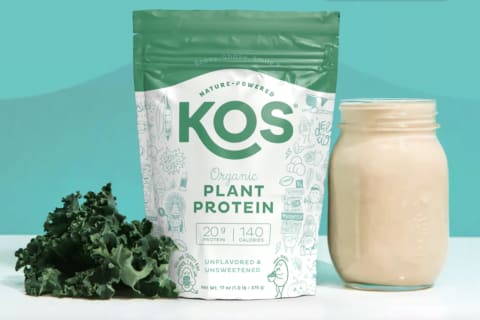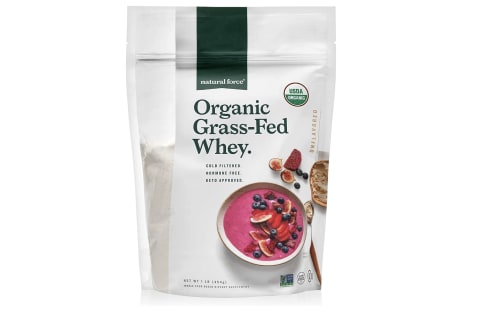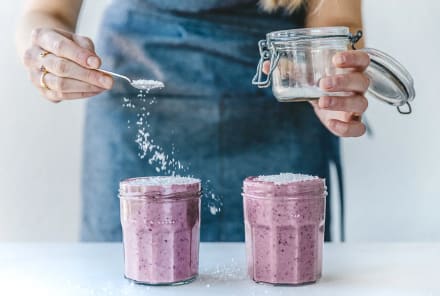Advertisement
8 Types Of Protein Powders + How To Find The Best Option (For You & The Planet)


Protein powders can help fulfill your daily protein needs and easily consume protein on the go. All protein powders provide a concentrated source of protein, but they're not all created equal.
We spoke with nutrition experts and protein scientists to review different types of protein powders and their functions to help you decide which one is best for you.
Whey protein
Whey protein is a milk-based protein and is a byproduct of traditional cheese-making. Renin is added to milk to separate the solids (casein) from the liquid (whey). The whey is further processed to become whey protein powder.
Some consider the disposal of whey to be the biggest environmental pollutant of the dairy industry1. From this perspective, converting whey into protein powder is a sustainable practice that keeps whey from going to waste.
There are different types of whey protein available, namely whey protein concentrate, whey protein isolate, and whey protein hydrolysate, which we cover in more detail below. How they are processed affects the concentration of protein and how fast they're absorbed.
Whey protein is mainly used to help build muscle2 and recover from workouts3. It has also been clinically shown to improve body weight and body composition4, especially when combined with resistance training and a calorie-restricted diet.
A meta-analysis of nine randomized control trials found whey protein supplements improved body weight, total fat mass, and some cardiovascular disease risk factors5 in individuals who are overweight or obese.
However, when it comes to fat loss and MPS, there is no demonstrated benefit of prolonged use of whey protein powder over other protein sources if dietary protein intake is sufficient.
"If someone is consuming protein at low to moderate doses per meal (less than 15 to 20 g) or overall intake is low to moderate (less than 0.6 to 0.8 g protein/kg body weight), there may be an advantage to consuming dairy-based protein powders such as whey," Stephan van Vliet, Ph.D. a scientist in the Center for Human Nutrition Studies at Utah State University, tells mindbodygreen. "When doses are high enough (more than 25 to 30 g per meal or 1.1 to 1.3 g/kg per day), it doesn't matter whether the protein is of animal or plant origin as you are providing more than enough amino acids at that point."
RELATED READ: The 5 Best Whey Protein Powders Of The Year
Whey protein concentrate
Whey protein concentrate (WPC) provides 60 to 80% protein, depending on its concentration, with the remaining 20 to 40% of its nutrient composition coming from carbs and fats. The most common forms of whey protein concentrate are WPC70 and WPC80, which provide 70 and 80% protein, respectively.
A review of eight randomized clinical trials6 found a significant reduction in fat mass in physically active adults using whey protein concentrate in comparison to those using whey protein isolate or whey protein hydrolysate.
While it depends on the product, one serving of unflavored whey protein concentrate typically contains about 10 grams of EAAs and 2.3 grams of leucine.
- Best for: Muscle gain, fat loss, athletic performance.
- Taste: Smooth, watered-down milk. Dissolves easily. Many flavors are available.
- Complete protein? Yes
- Price: $
Whey protein isolate
Whey protein isolate provides at least 90% protein by volume and goes through additional filtering to remove more fats and carbs. The extra processing also makes whey protein isolate virtually lactose-free and more digestible for people who might not tolerate whey concentrate.
While it depends on the product, one serving of unflavored whey protein isolate contains about 15 grams of EAAs and 4 grams of leucine.
- Best for: More digestible for some people, including those who are lactose intolerant. People on a fat- or carb-restricted diet.
- Taste: Smooth, light milk taste and dissolves easily. Many flavors are available.
- Complete protein? Yes
- Price: $$
Whey hydrolysate
Whey hydrolysate is the most processed of the whey protein powder options. It is produced by breaking down whey isolate into peptides of varying sizes, with bioactive peptides7, allowing the amino acids to be absorbed faster by the body.
Whey hydrolysate (in combination with resistance training) may be more beneficial for reducing body fat8 compared to whey concentrate or whey isolate. Supplementation of whey protein hydrolysate can also help reduce symptoms of exercise-induced muscle damage9 and improve recovery of muscle function.
While it depends on the product, one serving of unflavored hydrolyzed whey protein powders contains about 10 grams of EAAs and 2.2 grams of leucine.
- Best for: Reducing body fat, reducing exercise-induced muscle damage, and improving recovery
- Taste: Bitter
- Complete protein? Yes
- Price: $$$
Casein
Casein is known as a slow-digesting protein because it forms a gel in your stomach. The science on A1 versus A2 casein in humans is limited but suggests that A2 is less inflammatory10 and would elicit less gastrointestinal sensitivity11 than A1 casein.
Unlike whey, casein is not a byproduct of the dairy industry, so it may be considered a less sustainable source of protein.
Ingestion of at least 40 g of casein protein 30 minutes before bed could stimulate muscle recovery12, especially after resistance training in the evening.
Even though whey and casein have different absorption rates and bioavailability, there doesn't appear to be a difference in their performance-enhancing effects13.
While it depends on the product14, one serving of unflavored casein contains about 10 grams of EAAs and 2.3 grams of leucine.
- Best for: Overnight muscle recovery
- Taste: Feels thicker and lumpier in the mouth with a medium cheesy-milky flavor
- Complete protein? Y
- Price: $$
Pea protein
Pea protein powder is made from yellow split peas. The outer shells are removed, and the peas are ground and milled into flour. The flour goes through a process that removes the starch and fiber, leaving behind a paste that is dried into pea protein isolate. Salt is used in the process to make pea protein powders, so they're usually high in salt.
Twice daily supplementation of 25 grams of pea protein promoted a greater increase in muscle thickness15 compared to a placebo after a 12-week upper-limb training program. There was no significant difference between whey supplementation and pea protein supplementation.
In a pilot study, ingestion of 24 grams of whey or pea protein twice a day produced similar outcomes16 in body composition, muscle thickness, force production, performance, and strength following eight weeks of high-intensity functional training.
Unlike whey protein, pea protein is not considered a complete protein because it falls short on methionine/cysteine. But as long as pea protein powder isn't your only source of protein, this isn't too problematic.
While it depends on the product17, one serving of pea protein isolate contains about 10 grams of EAAs and 2.6 grams of leucine, so it's still considered a good-quality plant-based protein source.
- Best for: Vegans
- Taste: Grassy, earthy, bitter, and chalky. The mellow bean-like flavor can be disguised with added flavor.
- Complete protein? No
- Price: $$
Hemp protein
Hemp protein powder is made by pressing the oil out of whole hemp seeds and grinding them into a fine powder. Due to its wide range of use18 in industrial food production, fiber and construction materials, and its low environmental impact19, the hemp plant is considered highly sustainable.
Hemp protein may improve chronic inflammation20, but more research needs to be done on hemp protein as a meal replacement. Most of the studied health benefits of hemp21 are linked to hemp seed oil or hemp-derived CBD.
While hemp contains all nine essential amino acids, it's not considered a complete protein because it doesn't provide enough lysine. It's still a good-quality plant-based protein, though.
The amino acid profile and nutrient composition will depend on the product you choose. For example, there are some brands containing 8 g of fiber and others boasting 11 g of fiber in the same 30-gram serving size.
- Best for: Those who prefer less-processed protein sources and want more fiber and healthy fats in their diet. People with allergies.
- Taste: mild nutty flavor. Gritty or sandy when mixed with water.
- Complete protein? No
- Price: $
Egg protein
Egg-based protein powders are made by spray-drying egg whites, similar to the process used to make powdered milk. Outside of maintaining daily protein intake to support resistance-training-induced muscle hypertrophy22, more research is needed to determine if egg white protein powders have unique health benefits.
The egg industry faces growing concerns about sustainability23. Although cage-free and free-range are better for animal welfare, these chickens require more feed, which contributes significantly to greenhouse gas emissions.
Chickens raised in conventional cage systems are more efficient layers and require less feed, but their welfare may be at risk. For these reasons, egg white protein powders may not be considered a sustainable protein source.
While it depends on the product24, one serving of egg white protein powder contains about 11 grams of EAAs and 2 grams of leucine. Egg whites are considered a complete protein.
- Best for: People looking for a dairy-free, low-carb, or keto-friendly protein powder
- Taste: Similar taste to egg whites, which don't have much flavor
- Complete protein? Yes
- Price: $$
Collagen protein
Collagen supplements are made from the skin, bones, and connective tissues of animals like cattle, pigs, or fish. The proteins are turned into gelatin and then broken down to form a powder.
Since these parts of the animals would normally be discarded as a byproduct of the meat or fish industries, collagen powder can be viewed as a sustainable, upcycled product.
Collagen is a key component of hair, skin, and nails, which is why there are so many reports that collagen can provide positive dermatologic effects25. Collagen may also reduce bloating and improve mild digestive symptoms 26in healthy adult females.
"While it is suggested that collagen, because of the presence of high amounts of glycine and proline, can help with building connective tissue, there are no studies in humans to verify this claim at the moment," says van Vliet.
Because collagen has an incomplete amino acid profile, it isn't a good primary source of protein27 and shouldn't be used for muscle building.
- Best for: Those looking to improve skin, hair, and nail health
- Taste: Silky, tasteless and odorless. Dissolves completely in liquid
- Complete protein? No
- Price: $$
Cricket protein
Cricket protein flour is made by freeze drying, baking, and grinding crickets into very fine pieces to make a brown, powdery flour. Cricket flour is a potentially more environmentally sustainable alternative to other animal-derived proteins because it can be grown indoors, vertically, and in urban areas. Cricket farming also requires less water and less feed and emits fewer greenhouse gases28.
Standardized data on cricket's nutritional value is limited and inconclusive because it depends on developmental stage, sex, feed, and the way they are processed and prepared. For example, 100 grams of edible cricket meat can provide anywhere from 1.2 to 2 grams of leucine28.
Cricket flour is a complete protein source that provides healthy fats, vitamin B12, iron, and a prebiotic fiber called chitin. Eating cricket flour may improve gut health and reduce inflammation29.
- Best for: Those looking to add a healthy and sustainable protein source to their diet
- Taste: Mild, nutty flavor that mixes well with other ingredients
- Complete protein? Yes
- Price: $$$
Plant protein blends
"All proteins, including plant proteins, contain all nine essential amino acids. They are typically just lower in certain amino acids like lysine, methionine, and/or leucine," says van Vliet. "Combining plant protein sources, for example, pea with rice protein, can make for a more balanced amino acid profile."
Plant protein blends combine two or more plant protein sources like:
- Brown rice protein
- Pea protein isolate
- Pumpkin seed
- Hemp
- Chia seed
- Flaxseed
- Quinoa
- Oats
- Millet
- Amaranth
- Soy
Many brands use sprouted grains and seeds in their blends because they provide more nutrients30 and improve digestibility and absorption31. As long as the blend provides at least 2.7 grams of leucine to trigger muscle protein synthesis32, it can instigate the same exercise training adaptations as animal-based protein33, like strength and body composition and muscle recovery.
- Best for: Vegans, vegetarians, or people who don't tolerate milk-based protein
- Taste: Some have a gritty texture to them. Others have a smooth, creamy taste. They may taste earthy.
- Complete protein? Yes, depending on the blend
- Price: $$
The importance of leucine
The amino acid profile of a protein powder matters because there are nine essential amino acids (EAAs) your body cannot make that you must get from your diet. Leucine is especially important for muscle protein synthesis (MPS).
Jones suggests checking the amount of each amino acid on the label or on the supplement's website. "Look for about 10 grams of EAAs total34, with 2 to 3 grams coming from leucine35. This can easily be achieved via a whey protein, soy protein, or certain plant protein blends, including pea and brown rice, or pea and chia."
Note that depending on the type of protein, you may need to eat more to reach this leucine threshold. "In whey protein, leucine is about 12%, so 23 grams of whey protein isolate will trigger it [muscle protein synthesis]. Whereas in soy protein isolate, it's about 7.8%, so now you need 33 or 34 grams," protein and amino acid researcher Don Layman, Ph.D., previously told mindbodygreen.
How to choose a healthy, sustainable option
While animal protein tends to be less sustainable than plant protein, there's a case to be made that whey protein is better for the environment than some plant protein powders and certainly better than egg white protein powder because it repurposes whey and diverts it from becoming a pollutant.
As a bonus, if you source your whey protein powder from animals that are grass-fed, it may further reduce the environmental impact36.
"When considering the environment, I err toward plant protein blends that are also free of artificial ingredients such as artificial colors, flavors, and sweeteners," says performance dietitian and consultant Kelly Jones, M.S., R.D., CSSD. "However, there are some animal-based options that come ahead of others in terms of sustainability, including cricket."
Although hemp protein isn't the most popular protein supplement available, it appears to be one of the more sustainable plant-based options. The taste and texture can be off-putting to some, and it's low in lysine, so a plant-based blend that includes hemp protein might be a better way to go.
Shop sustainable protein powders
FAQ
What's the best type of protein powder for weight loss?
Protein powder can help support weight loss and protect lean muscle mass during a calorie-restricted diet. Whey protein concentrate and whey protein hydrolysate have both been shown to improve fat loss when combined with resistance training. Here's more on how to use protein powder for weight loss.
What's the best type of protein powder for muscle gain?
Protein powder can help support muscle gain when adequate calories and protein are consumed. Choose a protein powder that contains at least 10 grams of essential amino acids and 2 to 3 grams of leucine to support muscle protein synthesis.
Can protein powders replace whole foods?
While protein powders can be a healthy addition to your routine, they should never replace whole foods. "Since protein powders are typically isolated or concentrated sources of just protein, they are also typically lower in micronutrients than the actual food source it is derived from," says van Vliet.
"While protein powders can help meet protein needs, especially in the case of athletes, older populations, or hospitalized patients with an increased need for protein, consuming protein from whole foods is typically preferred to get the full spectrum of nutrients that whole foods can provide," van Vliet adds.
The takeaway.
There are many types of animal-based and vegan protein powders available depending on your dietary preferences, goals, and other criteria you might consider, like price, sustainability, or taste. Just keep in mind that protein powders are usually lower in macronutrients than whole protein sources, so be sure to incorporate plenty of high-quality whole-food proteins into your diet too.
36 Sources
- https://www.ncbi.nlm.nih.gov/pmc/articles/PMC8284110/
- https://pubmed.ncbi.nlm.nih.gov/29252039/
- https://www.ncbi.nlm.nih.gov/pmc/articles/PMC5537849/
- https://pubmed.ncbi.nlm.nih.gov/35871954/
- https://pubmed.ncbi.nlm.nih.gov/29087242/
- https://www.ncbi.nlm.nih.gov/pmc/articles/PMC6769754/
- https://www.ncbi.nlm.nih.gov/pmc/articles/PMC5355585/
- https://pubmed.ncbi.nlm.nih.gov/27710436/
- https://pubmed.ncbi.nlm.nih.gov/29106812/
- https://pubmed.ncbi.nlm.nih.gov/27039383/
- https://www.ncbi.nlm.nih.gov/pmc/articles/PMC5593102/
- https://pubmed.ncbi.nlm.nih.gov/32698256/
- https://www.ncbi.nlm.nih.gov/pmc/articles/PMC3761774/
- https://www.ncbi.nlm.nih.gov/pmc/articles/PMC4932579/
- https://www.ncbi.nlm.nih.gov/pmc/articles/PMC4307635/
- https://pubmed.ncbi.nlm.nih.gov/30621129/
- https://pubmed.ncbi.nlm.nih.gov/28847314/
- https://pubmed.ncbi.nlm.nih.gov/35146149/
- https://pubmed.ncbi.nlm.nih.gov/36766179/
- https://www.ncbi.nlm.nih.gov/pmc/articles/PMC7277103/
- https://www.ncbi.nlm.nih.gov/pmc/articles/PMC7891210/
- https://pubmed.ncbi.nlm.nih.gov/32576297/
- https://www.ncbi.nlm.nih.gov/pmc/articles/PMC8873942/
- https://www.ncbi.nlm.nih.gov/pmc/articles/PMC9316657/
- https://pubmed.ncbi.nlm.nih.gov/34694676/
- https://pubmed.ncbi.nlm.nih.gov/35639457/
- https://www.ncbi.nlm.nih.gov/pmc/articles/PMC6566836/
- https://www.ncbi.nlm.nih.gov/pmc/articles/PMC8067469/
- https://pubmed.ncbi.nlm.nih.gov/30018370/
- https://pubmed.ncbi.nlm.nih.gov/34401108/
- https://www.ncbi.nlm.nih.gov/pmc/articles/PMC6413227/
- https://www.ncbi.nlm.nih.gov/pmc/articles/PMC6245118/
- https://www.ncbi.nlm.nih.gov/pmc/articles/PMC8230006/
- https://www.ncbi.nlm.nih.gov/pmc/articles/PMC7469068/
- https://www.frontiersin.org/articles/10.3389/fnut.2021.685165/full
- https://www.ncbi.nlm.nih.gov/pmc/articles/PMC7435039/
Watch Next
Enjoy some of our favorite clips from classes
Enjoy some of our favorite clips from classes
What Is Meditation?
Mindfulness/Spirituality | Light Watkins
Box Breathing
Mindfulness/Spirituality | Gwen Dittmar
What Breathwork Can Address
Mindfulness/Spirituality | Gwen Dittmar
The 8 Limbs of Yoga - What is Asana?
Yoga | Caley Alyssa
Two Standing Postures to Open Up Tight Hips
Yoga | Caley Alyssa
How Plants Can Optimize Athletic Performance
Nutrition | Rich Roll
What to Eat Before a Workout
Nutrition | Rich Roll
How Ayurveda Helps Us Navigate Modern Life
Nutrition | Sahara Rose
Messages About Love & Relationships
Love & Relationships | Esther Perel
Love Languages
Love & Relationships | Esther Perel
What Is Meditation?
Box Breathing
What Breathwork Can Address
The 8 Limbs of Yoga - What is Asana?
Two Standing Postures to Open Up Tight Hips
How Plants Can Optimize Athletic Performance
What to Eat Before a Workout
How Ayurveda Helps Us Navigate Modern Life
Messages About Love & Relationships
Love Languages
Advertisement

Green Tea vs Black Tea: Caffeine, Health Benefits & When To Sip Each
Jillian Kubala, M.S., R.D.













